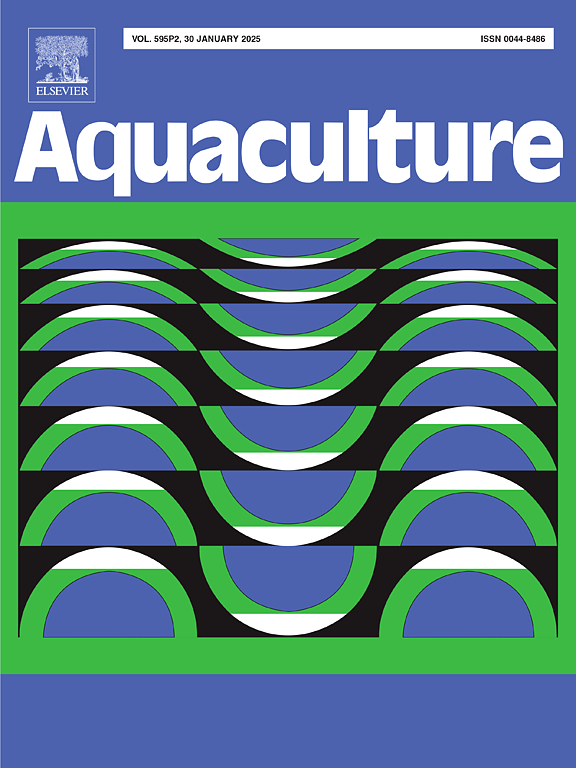低渗扩展剂冷冻介质用于鲟鱼精子冷冻保存的探索
IF 3.9
1区 农林科学
Q1 FISHERIES
引用次数: 0
摘要
本研究调查了多种鲟鱼物种(小鲟鱼、西伯利亚鲟鱼、俄罗斯鲟鱼和星状鲟鱼)的精子冷冻保存,测试了不同的低温介质和两种冷冻保存格式:小的0.5 ml塑料吸管,在聚苯乙烯泡沫塑料盒内的聚苯乙烯筏上快速冷却,大的4.5 ml和10 ml冷冻管在可编程冷冻机中进行受控的缓慢冷却过程。所测试的低温培养基包括一种新型低渗(相对于精浆渗透压)填充剂,其中含有1mm氯化钾、甲醇和不同浓度的乙二醇,以及传统的低温培养基。本研究评估了低温培养基对平衡期精子体积变化、受精成功率和胚胎发生的影响。值得注意的是,冷冻保护剂乙二醇和甲醇对精子细胞体积的影响不同:乙二醇导致精子细胞最初收缩,随后体积正常化,而甲醇不会引起精子体积的显著变化。主要研究结果表明,低温培养基中含有1 mM氯化钾、11%甲醇和2.5%乙二醇的低压扩展剂,有效地保存了解冻后的精子活力,在0.5 ml吸管和4.5 ml冷冻管中,西伯利亚鲟鱼的精子活力均达到46±6%;0.5 ml吸管占31±10%,10 ml冷冻管占40±12%;0.5 ml吸管为46±10%,4.5 ml冷冻管为39±8%,10ml冷冻管为44±11%。低温培养基还支持较高的胚胎发育和孵化率,在0.5 ml的吸管中,西伯利亚鲟鱼的胚胎发育和孵化率分别为81±16%和79±15%,在4.5 ml的试管中,西伯利亚鲟鱼的胚胎发育和孵化率分别为84±6%和82±7%。在0.5 ml吸管中,俄罗斯鲟的发育和孵化率分别为60±20%和57±20%,在4.5 ml冷冻管中分别为51±12%和48±13%,在10 ml冷冻管中分别为62±11%和48±13%。这些结果强调了这种替代冷冻保存方法在不同鲟鱼物种和样品体积中的有效性。然而,与新鲜精子和传统冷冻介质中冷冻保存的精子相比,使用1mm KCl扩展剂冷冻保存的精子的曲线速度(VCL)有统计学意义上的显著降低。然而,受精成功不受影响,并且在产生的胚胎中没有观察到明显的形态异常。本研究介绍了鲟鱼物种的另一种冷冻保存方案,证明了在不影响受精结果的情况下,使用含有1mm KCl扩展剂和大样本量(4.5 ml和10 ml冷冻管)的冷冻培养基的可行性。这一发现有助于推进低温保存技术,为鲟鱼养殖和保护提供了有希望的新可能性。本文章由计算机程序翻译,如有差异,请以英文原文为准。
Exploring cryomedium with hypotonic extender for sturgeon sperm cryopreservation
This study investigates sperm cryopreservation across multiple sturgeon species (sterlet, Siberian, Russian, and stellate sturgeons), testing different cryomedia and two cryopreservation formats: small 0.5 ml plastic straws, rapidly cooled on a polystyrene raft within a Styrofoam box, and larger 4.5 ml and 10 ml cryotubes subjected to a controlled, slow cooling process in a programmable freezer. The cryomedia tested included a novel hypotonic (relative to the osmolality of seminal plasma) extender containing 1 mM KCl, methanol, and ethylene glycol at varying concentrations, alongside traditional cryomedium. The study assessed the impact of cryomedia on spermatozoa volume changes during the equilibration period, fertilization success, and embryogenesis. Notably, the cryoprotectants ethylene glycol and methanol affected sperm cell volume differently: ethylene glycol caused initial shrinkage, followed by volume normalization, whereas methanol did not induce significant changes in spermatozoa volume. Key findings demonstrated that a cryomedium with a hypotonic extender containing 1 mM KCl, 11 % methanol, and 2.5 % ethylene glycol effectively preserved post-thaw sperm motility, achieving 46 ± 6 % in both 0.5 ml straws and 4.5 ml cryotubes for Siberian sturgeon; 31 ± 10 % in 0.5 ml straws and 40 ± 12 % in 10 ml cryotubes for Russian sturgeon; and 46 ± 10 % in 0.5 ml straws, 39 ± 8 % in 4.5 ml cryotubes, and 44 ± 11 % in 10 ml cryotubes for Stellate sturgeon. The cryomedium also supported high embryo development and hatching rates, with Siberian sturgeon achieving 81 ± 16 % and 79 ± 15 % in 0.5 ml straws, and 84 ± 6 % and 82 ± 7 % in 4.5 ml cryotubes. For Russian sturgeon, development and hatching rates were 60 ± 20 % and 57 ± 20 % in 0.5 ml straws, 51 ± 12 % and 48 ± 13 % in 4.5 ml cryotubes, and 62 ± 11 % and 48 ± 13 % in 10 ml cryotubes. These results highlight the effectiveness of this alternative cryopreservation approach across different sturgeon species and sample volumes. However, spermatozoa from cryopreserved samples with the 1 mM KCl extender showed a statistically significant reduction in curvilinear velocity (VCL) compared to fresh sperm and spermatozoa cryopreserved in traditional cryomedia. Nevertheless, fertilization success was not affected, and no significant morphological abnormalities were observed in the resulting embryos. This study introduces an alternative cryopreservation protocol for sturgeon species, demonstrating the feasibility of using cryomedium with 1 mM KCl extender and large sample volumes (4.5 ml and 10 ml cryotubes) without compromising fertilization outcomes. The findings contribute to advancing cryopreservation techniques, offering promising new possibilities for sturgeon aquaculture and conservation.
求助全文
通过发布文献求助,成功后即可免费获取论文全文。
去求助
来源期刊

Aquaculture
农林科学-海洋与淡水生物学
CiteScore
8.60
自引率
17.80%
发文量
1246
审稿时长
56 days
期刊介绍:
Aquaculture is an international journal for the exploration, improvement and management of all freshwater and marine food resources. It publishes novel and innovative research of world-wide interest on farming of aquatic organisms, which includes finfish, mollusks, crustaceans and aquatic plants for human consumption. Research on ornamentals is not a focus of the Journal. Aquaculture only publishes papers with a clear relevance to improving aquaculture practices or a potential application.
 求助内容:
求助内容: 应助结果提醒方式:
应助结果提醒方式:


